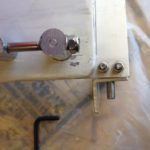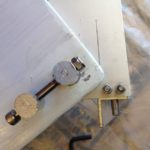An interesting aspect of helping Matt build his Race to Alaska boat is learning from him, the boat designer Rick Willoughby, and other contributors how important aero- and hydrodynamics are to creating an efficient boat. When you can only provide ~250 watts of propulsion power (or 500 in Matt’s case), rather than the normal 3600 watts you get from a 5 hp outboard, you need to minimize drag in order to attain admirable boat speeds.
Matt’s boat is version 16 of a pedal boat designed by Rick. This V16 R2AK is modified for the Race to Alaska in many ways, but one key one is the canting daggerboards. These foils are designed to be elevated above the waterline so that Matt can pedal without any water drag from them, and then lowered during sailing to to provide lateral resistance and lift that helps keep the boat from heeling.
When lowered to the maximum angle of about 55 degrees below horizontal, the leeward daggerboard will help with upwind performance. On a reach it could be raised to provide more lift, while on a run it can again be pulled up clear of the water.
Here are some photos of the dagger boards — both during construction and initial sea trials.
We ended up deciding to shorten the struts from about 63 cm to 58.5 cm LOA. This allows the struts to come up above the water line (and hopefully many of the smaller waves) and be lowered down to near 55 degrees below horizontal.
Here are the struts after being shortened experimentally to about 60 and 58.3 cm LOA…


It was clear during testing in the lake that the bare aluminum struts were creating a LOT of drag. Rick explained that fairing them (with a symmetrical foil shape) would reduce the drag by about a factor of 20. Sailing with them immersed was equivalent to pulling a second Rouleur hull behind us!
Here are a few more photos of the fairing of a second set of struts (made with slightly thicker walled aluminum tubing, too, I think). This set was faired with cedar, though we may fair the original tube with foam insulation to have a backup (lighter duty) second pair.
The astute reader will notice that I drilled the holes 90 degrees off in the ends of the struts! This was remedied by re-squeezing the ends (I did this in the vice already without cracking any epoxy, thankfully) and re-drilling (much easier to line up the holes when you’ve got the faired foil shape behind the bit in the drill press!). Any strength lost from the initial errant holes I hope to regain by injecting silica-epoxy plugs 2-3 cm into the tube ends.
I’m excited to see what these faired struts do for Rouleur’s speed. So far she’s not quite attained the sailing speeds that Rick expects from his modeling…
























